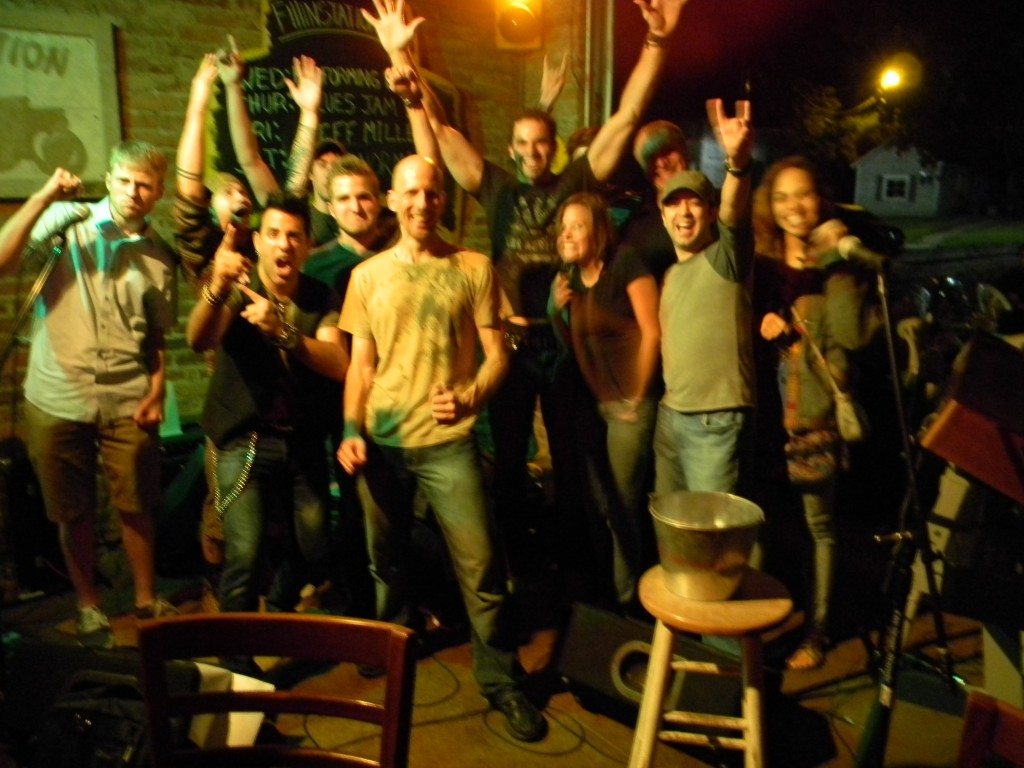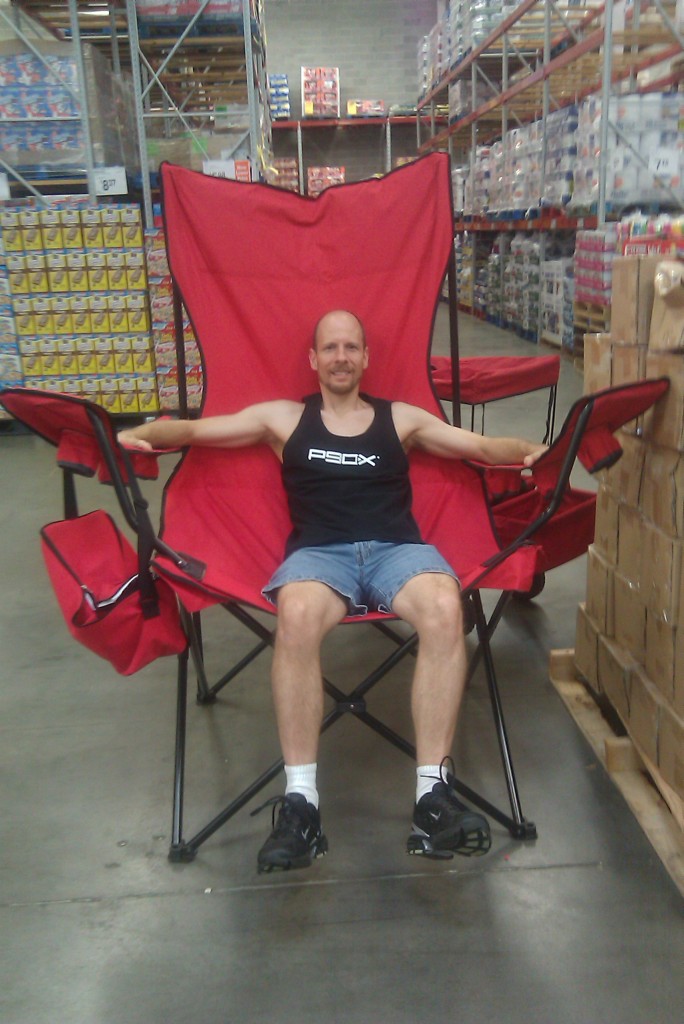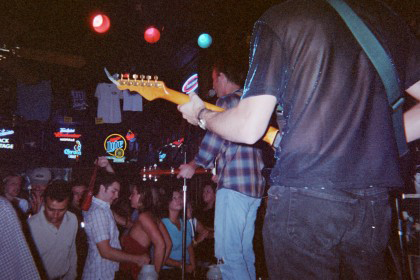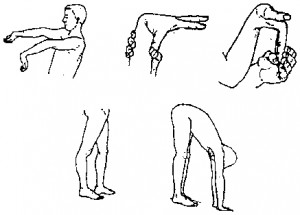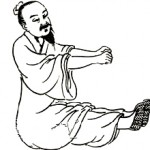Nashville Berklee Jam with Rich Redmond – June 5, 2012
The latest Nashville Berklee Jam last Tuesday was a great success, thanks to all who attended! The weather was beautiful, so we had a very laid back talk outside on the patio at The Fillin’ Station, our usual location for this event. Rich Redmond, the guest speaker on this night, has worn a lot of hats during his 15 years in Nashville – session/touring drummer, producer, clinician, public speaker, and his hour-long talk gave all in attendance some great perspective into different ways to navigate the Nashville music industry.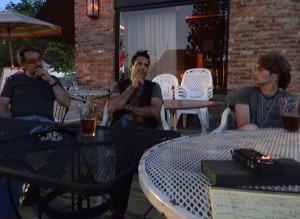
Rich spoke of the need to aggressively market yourself to find work in Nashville and how in his earliest days he obtained work by handing out demo cds of his drumming abilities to almost everyone he would meet around town. He candidly talked about those ‘lean years’, and that long before he was recording on hit records, touring the world with Jason Aldean, and producing acts like ‘Thompson Square’, he was hustling gigs on Broadway, playing in corporate party bands – whatever was necessary to insure survival.
For those who are just starting out in Nashville, he recommended that musicians “take every gig that’s offered”, as every new gig can potentially lead to new relationships and different career opportunities and that “If you give more to people then they expect, if you consistently exceed expectations, people are going to want to work with you.”
He spoke of the need to be ultra-professional by “always returning phone calls in a timely manner, always returning e-mails in a timely manner, being professional, being flexible, having the right gear to do the job and never mailing in a performance…”
Regarding the importance of reputation he said “You can have a great website, you can Tweet 1000 times a day, you can have a fantastic business card that’s got the really good paper, you know the really firm stuff that you have to pay extra for, and it’s still going to come down to word-of-mouth. In this [digital] age it’s so easy to be talked about in a positive or negative way, globally.”
During one part of the talk he mentioned a concept he refers to as “CRASH” a phrase he coined that stands for Commitment, Relationships, Attitude, Skill and Hunger – the five key ingredients he believes are necessary to succeed. He also spoke of the importance of defining your own success, a concept I talk about in my book “The Nashville Musician’s Survival Guide” (coincidentally, Rich contributed to the writing of this book).
After fielding several questions, he finished his talk and we all headed inside to make some music. Everyone who wanted to jam got a chance to sit in, and several great performances took place – ranging from classic rock covers to blues jams to originals. Rich stayed till the end making himself accessible to anyone who wanted to hang and chat, and during the middle of the jam he got behind the drum kit and played a few songs with me and several other alums. Here’s an MP3 of us playing a spirited version of the Jimi Hendrix classic, ‘Little Wing’ Little Wing Berklee Jam w Rich Redmond low. The night ended and we all headed home, but not until gathering for a group photo.
I want to thank everybody who came out and participated to make this another great event, see you at the next one! The next Nashville Berklee Jam will be held on Tuesday, July 10 – check back in a few days for info on the guest speaker for that night.
Stevie Ray Vaughan keyboardist, Reese Wynans talks at Nashville Berklee Jam
Some of my earliest childhood memories are of my dad playing records and, dare I say, reel to reel tapes of the music of Paul Butterfield, John Lee Hooker, Santana, and Derek and the Dominoes. I guess this music made an impression, because by my early teens in the early 1980’s I was buying my own records, not of the pop-based FM radio music of my generation, but of the previous generations more blues-based artists. While everyone else was listening to E.L.O. and Michael Jackson, I was discovering Jimi Hendrix, the Allman Brothers, BB King and Bobby Bland. Sure, I liked some of the 80’s guitar rock of the day, but always kept digging back to a more rootsy sound. Then right smack in the middle of 80’s hair band mania came Stevie Ray Vaughan, and I immediately related to his music.
Stevie’s music influenced a generation of guitarists and, at a moment where rock and pop music was winding itself up, almost single-handedly brought blues music back into the light. You couldn’t go see a club band during the late 80’s and early 90’s without hearing his music. I found myself covering his renditions of blues classics like “The Sky Is Cryin’”, “Empty Arms”, as well as originals like “Cold Shot” and “Walkin’ the Tightrope”, as did many others at that time. Stevie’s instrumental “Riviera Paradise” from the album ‘In Step’ is a beautiful piece of American roots music, and I always loved the spooky vibe created by his magical band on that song in particular.
I’ll never forget the day I heard of his tragic passing, how sad it was that we had to lose such a wonderful artist at such a young age. But his music, and the influence of his music, lives on, and I, like many others, will always appreciate everything Stevie did for music, and everything his music has done for the world.
So that’s why when I began hosting the Nashville Berklee Jam I felt compelled to 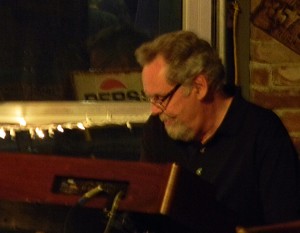 have Reese Wynans, the keyboardist who played with Stevie for the last five years of the great guitarist’s life, as a special guest speaker/performer. Reese was kind enough to share his story with me and a room full of alums at our monthly Nashville Berklee Jam last Tuesday at The Fillin’ Station.
have Reese Wynans, the keyboardist who played with Stevie for the last five years of the great guitarist’s life, as a special guest speaker/performer. Reese was kind enough to share his story with me and a room full of alums at our monthly Nashville Berklee Jam last Tuesday at The Fillin’ Station.
Almost 20 years before he began working with SRV he was playing in cover bands in his home state of Florida, and he recounted one of his first bands playing five sets a night, six nights a week. Two of the other members were Dickey Betts and Berry Oakley and on their one day off they would play a weekly free jam, adding Duane Allman and Butch Trucks to the mix. Eventually Duane decided to start his own band and stole these key members to form The Allman Brothers.
After spending a few years in San Francisco and working with a still-unknown artist at this time, Boz Scaggs, he returned to Florida for a brief period and then worked the East Coast in a show band for a few years. Reese then migrated to Austin, Texas, a booming town full of blues-infused music by this point of the mid-70s. Of this time, Reese spoke passionately.
“It was really great for me living in Austin…everything was so rootsy…they had a great music scene back there in the 70’s. They had a great blues scene, and a great blues club called ‘Antone’s’…and I would go and sit in at Antone’s anytime I had a chance. I was ending up really lovin’ the blues during this time.”
By 1980 he found himself working for Delbert McClinton, playing on four of his records and touring extensively for the next five years. By 1985, Reese was ready to get off the road, and would have if not for a fateful encounter at the end of his final gig with Delbert. Apparently, Delbert’s sax player had been invited to play on one song of a Stevie Ray Vaughan recording session after Delbert’s concert, and at the last minute Reese was asked to join in as the other keyboardist did not show up. Things went very well at this particular recording session, one which produced the hit, “Look at Little Sister” and Reese was asked to come back and record the following day. By the end of that recording session he was asked if he wanted to join the band. Reese summed up a life lesson from this critical moment,
“When a door opens for you, you’ve got to be willing to walk through it, and then be able to deliver once you get through there.”
The next five years would yield three Grammys, several world tours, and a reintroduction of the blues to the masses –
“We were spokesman for Texas blues…as much as Stevie didn’t want to, BB King had to open for us, because we were just more popular than him. He said “no we can never, BB’s always closing the show”… but finally, we had to headline…I loved playing in that band…we were all totally immersed in the blues, and we felt like were the vanguard of the blues. We were dragging Buddy Guy and Otis Rush into the light and presenting them out on our shows to people who were just hungry for that music…the stuff that we played I thought was shining a light on all the huge blues guitar players that had come before us, and that was a wonderful thing to do, I felt like it was really worthwhile.”
 After Stevie’s tragic passing, Reese wound up in Nashville, TN, a place where he has continued to record and perform on a national level. During the talk, Reese passed around his All Music Discography, which reveals a staggering body of work, including Brooks and Dunn’s 2006 single of the year “Believe”. He offered us some thoughts about the differences between studio and live performance –
After Stevie’s tragic passing, Reese wound up in Nashville, TN, a place where he has continued to record and perform on a national level. During the talk, Reese passed around his All Music Discography, which reveals a staggering body of work, including Brooks and Dunn’s 2006 single of the year “Believe”. He offered us some thoughts about the differences between studio and live performance –
“I like being in the studio, I like playing gigs, I like playing clubs…all you people who do studio work know it’s two different things. Playing a club is really a chance to experiment…a chance to reach out in different directions and really find yourself. The studio isn’t really a place for that. The studio is where you don’t have to play it safe, but you’ve got to do something that’s exactly right for the  song…it’s a place for finding something that works, finding something unique that works.”
song…it’s a place for finding something that works, finding something unique that works.”
After his talk was finished, Reese was gracious enough to perform a set with our house band – a performance that was nothing short of inspired. I’ve heard his playing on many records, but there’s something intangible that you can feel in the heat of live performance that goes beyond a recording, and that was evident on this night. One of the songs we played together was “Little Wing”, a song that he had played on tour with Stevie, back in the day. On this song, Reese seemed to really stretch out in one of those magical musical moments in which time seems to stand still (see video below).
Eventually, this special night had to end, and we said goodbye after a quick photo op. Thanks, Reese, for sharing your wisdom, and for continuing to shine some light on that crown jewel of American music we call the blues.
Nashville Berklee Jam with Judy Rodman – March 6, 2012
Our second “Nashville Berklee Jam” at The Fillin’ Station in Kingston Springs this past Tuesday was a great success! The guest speaker on this night was none other than Nashville’s award-winning vocal coach, Judy Rodman. Judy has played many a role in the Nashville music industry 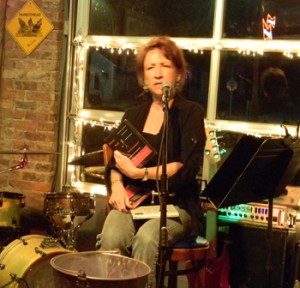 over the years – recording artist, A-list session singer, producer, hit songwriter – and on this night her talk focused on different career paths for vocalists. Judy was involved in the writing of my book “The Nashville Musician’s Survival Guide” and, backing up my theory of the necessity to “wear a lot of hats”, she talked about multiple streams of income for today’s musicians and artists. Among the potential jobs for vocalists she outlined were artists, live singers, and session singers (jingle singers, background vocals, demo singing, and voiceovers).
over the years – recording artist, A-list session singer, producer, hit songwriter – and on this night her talk focused on different career paths for vocalists. Judy was involved in the writing of my book “The Nashville Musician’s Survival Guide” and, backing up my theory of the necessity to “wear a lot of hats”, she talked about multiple streams of income for today’s musicians and artists. Among the potential jobs for vocalists she outlined were artists, live singers, and session singers (jingle singers, background vocals, demo singing, and voiceovers).
Here are a few excerpts:
“Recording artists need vocal ability, because the mark is up. Even with pitch fixing, rhythm fixing…your vocal needs to be as good as it possibly can be because it’s going to sound more natural and it’s going to be more emotionally compelling…You also need a ‘unique artist definition’…it’s not good enough to be just another great singer…you really need to be unique and find your own definition as an artist – your uniqueness, your vocal uniqueness – which means you need to explore your whole voice and your life experiences that you’re going to put into your art. The sound of your artistic definition is going to have to do with the sound of your voice, the choice of your instrumentation, and your message… Artistic definition takes exploration. For those of you wanting a career as a recording artist I would say don’t shortcut your experimentation.”
“For live background singing – you need to have the ability to trace and completely blend and go with the nuances of the voice of the singer you are looking to back…You’ve got to be able to change your sound as the artist wishes…you will of course have to have the ability to sing harmony parts and hear them… you have to have a specific look – whatever the artist is looking for. You need to network and find out who is gigging, who is in need of background vocalists.”
“Session singing…You need great vocal technique, usually you’ll need some vocal training…you really need to have surgical control of your voice for pitch, sound, blend and nuances –because time is money in the studio…You need to of course hear harmony parts quickly, you need to have the ability to read manuscript…but you also need to know the Nashville Number System.”
Judy then gave some practical vocal technique tips before answering several questions from alumni. Click on the following links if you would like to hear her talk in its entirety.
Judy Rodman Talk – Part One (21 min)Judy Rodman Talk – Part 1 (21 min)
Judy Rodman Talk – Part Two (21 min) Judy Rodman Talk – Part 2 (21 min)
There is also a ton of useful and practical information for vocalists at Judy’s website www.judyrodman.com.
When her talk concluded we began the jam portion of the evening with our house band backing Judy for two songs to start things out. Her second tune, “One Way Ticket”, was a number one hit she wrote that was cut by LeAnn Rimes. Judy’s vocal performance was emotionally 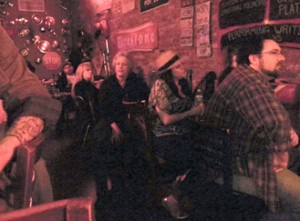 charged and inspiring to say the least, and this set the tone for the rest of the evening. A special dynamic on this night was the “optional vocal performance critique” that Judy offered for willing participants. To break the ice, I decided to go first and sang my two songs with the house band. After my first song, Judy pointed out some of the strengths about my performance and addressed a few things to work on.
charged and inspiring to say the least, and this set the tone for the rest of the evening. A special dynamic on this night was the “optional vocal performance critique” that Judy offered for willing participants. To break the ice, I decided to go first and sang my two songs with the house band. After my first song, Judy pointed out some of the strengths about my performance and addressed a few things to work on.
The jam continued with several great performances. Brian Lucas, the house keyboardist, sang a great rendition of “Georgia”, for which he took the vocal critique option. This pattern continued for the rest of the night, with literally every vocalist asking for a critique. Among these were Ted Schempp, the vocal duet “Acklen Park” (performing songs they co-wrote with alum, Shantell Ogden), Sarah Tollerson, and Michelle Lambert – all performing original 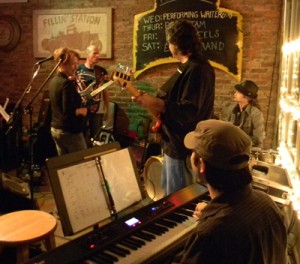 material. After the first song by each performer, Judy offered critiques and then we would try a part of the song again, seeing instant improvement in the vocals (don’t get me wrong, the vocal performances were pretty strong to begin with). Alums, Elton Charles on drums and Rick Carizales on guitar, also sat in and did a fine job backing up some of the guests. Brian Lucas made a big contribution by charting out many of the songs in advance, and Shantell helped out by taking photos and some great video excerpts (see below).
material. After the first song by each performer, Judy offered critiques and then we would try a part of the song again, seeing instant improvement in the vocals (don’t get me wrong, the vocal performances were pretty strong to begin with). Alums, Elton Charles on drums and Rick Carizales on guitar, also sat in and did a fine job backing up some of the guests. Brian Lucas made a big contribution by charting out many of the songs in advance, and Shantell helped out by taking photos and some great video excerpts (see below).
It really was a special evening, fun was had by all and I think everybody learned a few things too. I want to thank Judy Rodman, our house band (Heston Alley on drums, Tom Good on bass, Brian Lucas on keys) and all the alums who participated and helped make this a special evening, I can’t wait for the next one!
The next Nashville Berklee Jam will be held on Tuesday, April 10th at the Fillin’ Station with special guest, Reese Wynans, formerly of Stevie Ray Vaughn & Double Trouble. His talk will share perspective on being a lifelong career musician, working with SRV, and the importance of understanding blues and roots music. Please check our website regularly for updates.
A Big First Night for the Nashville Berklee Jam!
Last night’s “First Tuesday of the Month Nashville Berklee Jam” was a huge success! The otherwise quiet Nashville suburb of Kingston Springs came alive as the alums began filtering into The Fillin’ Station for this night of camaraderie and music.
The mission of this monthly event is to help build our Berklee community in Nashville, and for the first hour, old friends reunited and new friendships formed over lively conversation in this quaint setting. Shortly after 8 pm I made a few brief announcements before introducing the night’s guest speaker, A-list session bassist, Mike Chapman.
new friendships formed over lively conversation in this quaint setting. Shortly after 8 pm I made a few brief announcements before introducing the night’s guest speaker, A-list session bassist, Mike Chapman.
Mike’s talk centered on his lifelong career as a session player and he compared what he considers the key ingredients to being a successful studio musician to slices of a pizza.
The essential slices of the “session player pizza” include:
- Talent and Skill
- Positive Attitude
- Strong Work Ethic
- Flexibility
- Taste
In talking about the support role that musicians play on a recording, Mike commented “there’s a big difference between something that is fun to play, and something that is fun to listen to”, noting that they are not always the same thing. He also added that “musicians, both live and in the studio, are essentially in the service industry, and it’s our job to provide the window dressing to the song or artist”. Another point he couldn’t drive home hard enough was how essential it is to know “The Nashville Number System”, as this is the main way songs are charted in Nashville, again, both live and in the studio, and the book bearing the same title by Chas Williams is a great way to learn.
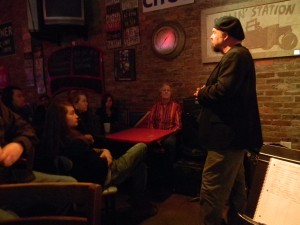 After Mike answered some questions from several alums it was time for some music. To get things started, I took the stage with our house band, consisting of Mike on bass and fellow alums, Heston Alley on Drums and Brian Lucas on Keys. We started out with a spirited version of Freddy King’s “Key to the Highway”, Paul Butterfield’s “Born in Chicago” (featuring bar owner, Patrick Weikenand on harp) and one of my favorites, “Ain’t Wasting Time No More”.
After Mike answered some questions from several alums it was time for some music. To get things started, I took the stage with our house band, consisting of Mike on bass and fellow alums, Heston Alley on Drums and Brian Lucas on Keys. We started out with a spirited version of Freddy King’s “Key to the Highway”, Paul Butterfield’s “Born in Chicago” (featuring bar owner, Patrick Weikenand on harp) and one of my favorites, “Ain’t Wasting Time No More”.
Our next grouping featured Ted Schemp on guitar and vocals and Elton Charles, a recent arrival to Nashville, on drums, and we played one of Ted’s originals followed by an instrumental blues jam. Sofia D got up and played some funky drums behind George Wong on bass and Ben Graves on guitar and vocals. Ben led us through a cool version of the Sam Cooke classic “Cupid” before Sarah Tollerson, host of another Alumni event, “Strength in Numbers” (held on the second Wednesday of each month at the Riverfront Tavern in downtown Nashville) joined us to sing “Oh Darlin’” and “You Make Me Feel like a Natural Woman”.
Michelle Lambert, another recent newcomer, brought charts for a couple of originals and delivered some emotive vocals interspersed with some fine fiddle playing to a couple of arrangements on the fly. Bassist, Keiffer Infantino got into the mix with another recent arrival, guitarist Rick Carrizales, and at this point Ben Graves came back up to play some sax. We played a funky jam in A minor and everybody got to stretch out before our final tune of “Freddy the Freeloader”, for which Mike Chapman got back up to finish the night.
If there’s one thing I have learned from all of the alumni events I have attended, it would be that Berklee alums are some of the nicest people you’ll ever meet. And that open, warm feeling was evident in both the conversations and music that took place on this cold February night. I would also add enthusiasm to this list of traits, as there was an infectious, electricity in the air during these performances.
This jam was our first of many to come, as this will be held on the first Tuesday of each month, and the Nashville Berklee Jam website will serve to keep alums informed about future jams and all of the upcoming Nashville alumni events. I would also like to encourage interactivity on this site, so don’t be afraid to post, comments, songs you would like to play or any other ideas you may have. On that note, I’m looking for volunteers to take photos and possibly shoot a few video clips of our next jam for future blogs.
Thanks again to all those who participated in making this night a great success and see y’all at the next one!
For those who are new to Nashville, or considering relocating to Music City, my book “The Nashville Musician’s Survival Guide” is a street level perspective of the music related jobs found here, and the ultimate companion for today’s musicians, songwriters and artists. Decades worth of information learned on the streets of Nashville for $20! How can you go wrong?
Eric’s Monthly Newsletter: February 2012
I hope everybody is having a great winter so far and that 2012 will be a great year for us all. February is looking to be a busy month for me and I would like to tell you about some of these gigs and events.
Thursday, February 2nd I’ll be playing a benefit show for “My Friend’s House”, a group home for boys in Williamson County, TN. The benefit will be at Mickey Roos in Franklin starting at 7 PM and will feature a ton of great Nashville talent. One of the organizers of the event, Keith Landry (currently of the band Leroux, (former credits including harmony singing for Toto and Lee Greenwood) will be fronting a set of classic rock ‘n roll and coordinating the guest musicians. Some of the music we will be covering will be songs from Journey, the Doobie Brothers, Toto, Van Halen, and others. This just might be the most rock music I will have played in one night since moving to Nashville! It’s a great cause, so come on out!
Tuesday, February 7th will be the first ever “Nashville Berklee Jam”, featuring special guest, Nashville session bassist and former “G-man” Mike Chapman. This is something I have been working on for quite some time, and will take place on the first Tuesday of each month at The Fillin’ Station in Kingston Springs, TN.
Friday, February 10th I’ll be playing a gig with Nashville songwriter and artist, Carl Wayne Meekins at the world famous Puckett’s Grocery in Leiper’s Fork, TN. Carl is a fabulous performer and a great guy and I have been fortunate to do several gigs with him over the last several months. The band on this night will feature some top-notch Nashville session players, so come on out and support some great live music!
Saturday, February 11th will be my monthly outing at The Fillin’ Station in Kingston Springs, TN. The lineup on this show will be Heston Alley on drums, Tom Good on bass, and yours truly on vocals and guitar. Patrick will be behind the bar and guesting on harmonica throughout the night. Come get your blues rock fix with us!
Towards the end of February I will be playing with upcoming Nashville artist and South African native, Mirka at Nashville’s 3rd and Lindsley. Our set of original material will be part of a monthly showcase hosted by Nashville producer and guitarist, Kent Wells. The date hasn’t been set yet, I’ll let you know as soon as it is.
My book, “The Nashville Musician’s Survival Guide” received a great review on the popular Nashville blog “Music News Nashville”, follow the link above to check it out. I also submitted the book to The Country Music Hall Of Fame and there’s a good chance they will start carrying it this spring!
And completely unrelated to music, I have decided to enter in an annual event called the Warrior Dash that will take place in middle Tennessee on September 22nd. This is essentially an off-road 5K race integrated with an obstacle course that includes things like climbing a rope wall, jumping over a fire pit, crawling under barbed wire through the mud, etc. I may or may not be in the shape I need to be for this event at the moment, but the goal is to be in good enough shape to kick some serious ass on this course come September! Similar events take place all over the country and you can learn more about it on the website above. Anybody out there want to take the challenge?
So that’s about it, I’m excited about the possibilities that this New Year might bring and looking forward to making new friends and playing some great music!
P.S. If you haven’t yet picked up a copy of my book, “The Nashville Musician’s Survival Guide”, you owe it to yourself to check it out! Available in hard copy and ePub.
The Gig I Thought Would Never End
Have you ever played a gig that seemed to go on forever? I’m not talking about your typical three to four hour bar band performance that occasionally might drag a little in the middle, or some uninspired club gig full of “T n’ A” (tables and ashtrays). No, I’m talking about a gig that goes on for hours and hours, eight hours to be exact, by the end of which you felt like you aged 10 years. A few years back I did a few gigs like this, and lived to tell about it.
With thousands of singers and musicians trying to break into the Nashville nightclub scene and only so many potential gigs, the scene here can be quite competitive. And if you’ve been in Nashville for a while, you know all too well that these clubs are not known for their “great pay”. These two facts combined might cause some players to take on gigs that, in another part of the country, would be laughed 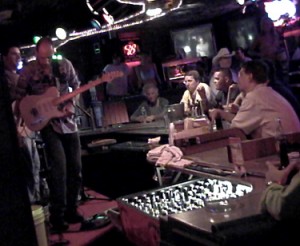 out the door.
out the door.
Don’t get me wrong; there are some club gigs around town that can be lucrative, a few even providing a guarantee of $100 or more per player. But most club gigs in Nashville are tips only, or provide a minimal base pay (usually $20-$50 per player), plus tips. So if you want to make some decent money, you really have to hustle.
Relying on tips causes many club bands to play a three to four hour shift without taking a break, and if a player needs to go to the bathroom the singer might do a few acoustic numbers to provide the band with at least one “pee break”. Relying so greatly on the tip jar for income also causes some singers and bands to exclusively cater to the tourists, choosing worn out dance floor classics like “Margaritaville”, “Sweet Home Alabama” and “Mustang Sally” to keep them happily bopping along.
Several years back I was working pretty steadily downtown, playing a lot of shifts at Tootsies, the Second Fiddle, and a few others on the strip. Around the same time there was another club just a few streets off of Broadway at which I also began performing (to save face, this club will remain anonymous, although its identity will be obvious to anyone who has ever worked this gig). For the purposes of this blog, I will refer to the club owner as “Harry” and the club as “Harry Houdini’s”.
I got to know Harry by hanging out at his club and sitting in on occasion. He liked my playing, and when the guitarist in his weekend house band quit, he offered me the spot. I was hungry for good paying work, and he offered to pay me $125 a night – straight pay with no tips. By Nashville standards, this was great pay for an in-town club gig. There was just one catch – the band was required to play from 7 PM to 3 AM. What?
“Don’t worry, I’ll give you plenty of breaks” Harry assured me. “You can even play sitting on a stool when you get tired”.
Like I said, good paying gigs are hard to find in Nashville, and at this point in time I really needed the dough. Besides, I had already experienced playing some “doubles” on Broadway (for those of you not in the know, this is two shifts back to back, with about a 30 minute break in between shows for change over). The doubles were hard work, but I had built up the necessary stamina, and the extra pay was helping. So what the hell, it can’t be much worse than a double, why not give it a shot?
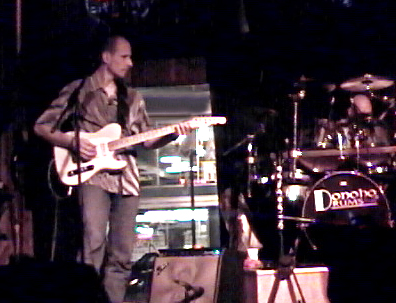 The day of my first gig at this fine establishment I arrived about 20 minutes early, loaded in my gear, and anxiously awaited downbeat. The group consisted of drums, bass, me on guitar, and a singer who also played acoustic. The song list was typical of downtown cover music – classic and new country, pop and rock, and for the first couple of hours, it seemed like just another typical bar gig in Nashville. I even got to take a short break around nine.
The day of my first gig at this fine establishment I arrived about 20 minutes early, loaded in my gear, and anxiously awaited downbeat. The group consisted of drums, bass, me on guitar, and a singer who also played acoustic. The song list was typical of downtown cover music – classic and new country, pop and rock, and for the first couple of hours, it seemed like just another typical bar gig in Nashville. I even got to take a short break around nine.
Then the dynamic of the night began to change. Harry, the club owner, was also a musician, and he came up and sang a set with the band. Some of the songs we played were the previously mentioned classics of “Margaritaville”, “Sweet Home”, and “Mustang Sally”, but we also added to the mix other worn-out wonders like “Brown Eyed Girl”, “Family Tradition”, and the often dreaded “You Never Even Called Me by My Name”.
It was a warm Friday night and the crowd, which seemed to be mainly tourists, seemed happy with what we were doing, we even got a dance floor going. The singer/owner finished his set and went back to work behind the bar, and the other singer came back to take over for a while. Another 45 minutes or so and we got our next pee break while the singer sang a couple tunes solo with his acoustic.
It was now after 11 o’clock, about the average length of a typical bar gig, and Harry again returned to the stage. To my surprise, this next set contained several of the same songs that we played in his first set, most of them being the aforementioned “classics”, a couple of which had also been covered by the other singer.
On our next pee break, sometime around 12:30 AM, I mentioned to the drummer something like “Boy he really likes those oldies. Does he always repeat those songs so much?”
“You ain’t seen nothin’ yet, we’re just getting started. Typically, he wants us to play Margaritaville, Sweet Home, Mustang Sally and Family Tradition about once an hour.” he said to my amazement. “His theory is that the tourists love these songs, and that with the high turnover, it doesn’t really matter how many times we play them.”
Ooookaaay.
Moments later I resumed my perch on the stage to continue my birds-eye view of this top 40 adventure, one that seemed to be entering some kind of classic-hit time warp. I remember looking up at the clock behind the bar a little while later and it reading something like 12:48. Except for the three or four 10 minute pee breaks, I had been playing this gig for about six hours, with two more hours to go, and it began to feel like I had been on the stage for days.
The crowd was now pretty thin, but we marched on. With Harry back on the mic, he asked the crowd “do we have any Lynyrds Skynyrd fans in the house?” With a couple of random cheers forthcoming, we launched into Sweet home Alabama again, now for the fifth time. The same thing happened with some of the other classics. I looked up at the clock a little while later and it was around 1:30. The more we kept repeating songs, the slower the clock seemed to move. At one point my mind flashed to the scene in the movie “Risky Business”, where the character played by Tom Cruise witnesses the clock going backwards right before the bell was supposed to ring.
By the end of the night, I was drenched in sweat and physically and mentally exhausted. My back was sore, my fingers shredded, and my mind numb. We had played Sweet Home Alabama, Mustang Sally, and Family Tradition seven times each throughout the night. Some of the other songs we played four to five times a piece. The funny thing was, the patrons never seemed to notice or care. Harry was right; there was a high turnover, and whatever crowd we had at any given moment seemed to enjoy the songs.
I collected my pay and went home, returning the next evening to do it all over again. As lucrative for an in-town gig as this was, I only lasted a few short weekends before moving onto something else. After a few years I was able to get over my “classic hits overdose”, but for the months following this episode, I suffered severe flashbacks every time somebody called out Sweet Home Alabama and Mustang Sally.
Meeting a Sandcastle at High Tide
It was a warm summer afternoon in a small town in southern New Hampshire, back in the summer of ’79, and it had finally arrived. Summer vacation had just begun, and for this group of friends gathered around the family pool, the air was ripe with the kind of optimism and mystery that only a teenager can have – you know, that “anything can happen” feeling that occupies the youthful soul. Staring at the pool in cheerful content, they basked in the warmth of the sun while listening to the “Woodstock” soundtrack booming out a bedroom window. The youngest in this pack, a 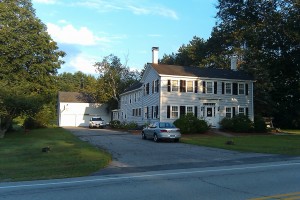 couple of eleven year old boys who were a few months away from starting junior high, seemed more than intrigued by some of these “new” electric sounds permeating this virgin summer air.
couple of eleven year old boys who were a few months away from starting junior high, seemed more than intrigued by some of these “new” electric sounds permeating this virgin summer air.
“What’s the name of this band?” asked one of the youths.
“That’s ‘Sly and the Family Stone”, answered Dave, the boyfriend of one of the younger lads’ older sisters.
“Wow, this is really cool!” the excited boy answered.
Up until this moment, these youngsters, like most pre-teens from this era, had been mostly hearing the corporate radio music of the day – a post-disco fallout period with bands and artists like E.L.O., Michael Jackson, and The Eagles providing a daily dose of saccharine for the masses – “Don’t bring me down…..Brrrruuucccce!”
“If you like Sly, you’re really going to love the last side of this record!” he confidently announced, and a short while later, everything changed.
It was as if a bomb had gone off – suddenly, the music coming out of the speakers sounded more like a science fiction movie soundtrack than it did the groovy “freedom rock” that had played just minutes before. Sounds that seemed to begin as single guitar notes ended as explosions – harmonic cascades and otherworldly sounds swirling into the stratosphere – “sheets of sound”. This music spoke of the epic joys and tragedies of the human struggle – war, hunger, love, peace, poverty, anarchy, inequality – it was all there, yet not a single lyric had been sung.
Near speechless, one of the 11 year olds turned to his friend and managed to say “this is amazing!”
“I thought you might like this” was the response, and they continued to marvel in the sonic wonderment, this new discovery rendering a near out of body experience.
With each passing moment came a new level of heightened awareness for the one boy in particular. It wasn’t as if he had never heard great music; many years before, his dad had turned him on to Santana, John Lee Hooker, and many other  greats from the golden era of blues and rock. But this was different. This music transcended all of the traditional music forms that he had heard before. Melodically, it was free from the constraints of the pop song, or even blues format, yet it was bluesy. Rhythmically, it seemed connected to the earth in an intangible way, kind of tribal, with roots going deep into the African jungle. It was as if these sounds came right out of the sky, from the heavens, not a speaker in a window.
greats from the golden era of blues and rock. But this was different. This music transcended all of the traditional music forms that he had heard before. Melodically, it was free from the constraints of the pop song, or even blues format, yet it was bluesy. Rhythmically, it seemed connected to the earth in an intangible way, kind of tribal, with roots going deep into the African jungle. It was as if these sounds came right out of the sky, from the heavens, not a speaker in a window.
This music “spoke” to the young boy with a clarity he had not yet experienced in life, rendering this otherwise insignificant summer day the birth of the universe for him. It felt like a calling, like this was the day his life really began, the birth of an endless pursuit to the new sense of self and spirituality that permeated his being on that warm day in the sun long ago – like ocean waves meeting a sandcastle at high tide.
That was the day I first heard the music of Jimi Hendrix.
“New to Nashville” Berklee Alumni Reception
Berklee is alive and well in Nashville! On Monday, November 7 we had our first “New to Nashville” Berklee alumni reception at the NSAI studio on Music Row, and the event was a huge success. Upon the suggestion of Berklee Alumni Affairs Officer, Karen Bell, I put this event together to welcome alum’s who recently relocated to Nashville.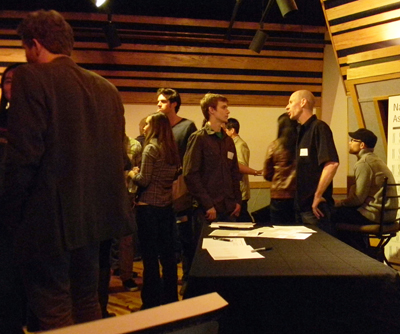
The reception was a three stage event. The meet and greet gave recent transplants a chance to reconnect with their fellow classmates while forming new relationships with some of the alumni who have already been here a while. From what I could tell, out of the 40 or so in attendance, at least half were new arrivals.
After about an hour, everybody took their seats and I gave a brief talk about my Nashville experiences. The talk evolved into a pretty good group discussion, with lots of questions about networking in Nashville. Most of my experience in Nashville has been in the areas of touring, gigging around town, and recording, and most of this discussion centered on these issues.
One alum asked about what clubs and situations would lend themselves for sitting-in with bands. Sitting-in is a great way to build your reputation while making connections that might lead to gigs, and I mentioned a few that are worth checking out – The Fiddle and Steel has a player-friendly jam every Tuesday night; Douglas Corner has “The Loud Jazz Players Jam” every other Monday night; and there are also a few blues jams around the city including one at Carol Ann’s Café on Sunday nights, and The Fillin’ Station on Thursday nights. I also suggested becoming a regular at some of the clubs on Broadway, as this is also a good place to meet players who are gigging regularly.
Rich Redmond, one of the contributors to my book “The Nashville Musician’s Survival Guide”, has one piece of great advice he gives to players who are new to town, and I passed this advice on in response to a question about evolving a music career in Nashville – “Be patient, and take every gig that is offered”. Every gig will potentially lead to more gigs, and no matter how unimportant some gigs might seem, you never know where those roads might lead.
We paused briefly after my talk to give everyone a chance to stretch their legs and grab some more 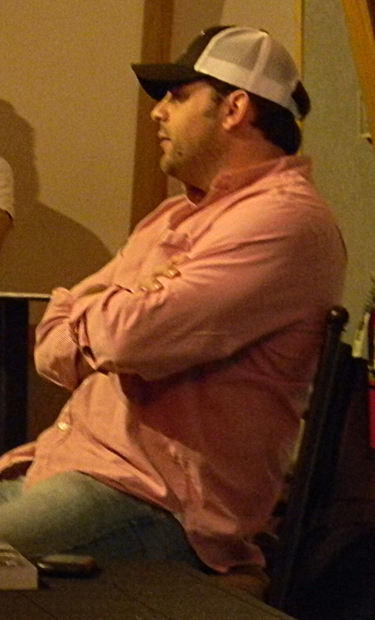 refreshments. Then everybody settled back down into their seats and I proudly introduced the night’s final speaker – country music artist, hit songwriter, BMI songwriter of the year, and my current boss, Rhett Akins. For those of you who aren’t in the know, Rhett is currently one of the hottest songwriters in Nashville, and he shared some great perspective, stories, and advice for all of the songwriters in the room (and judging by a show of hands a little earlier, at least half of those in attendance had come to Nashville to pursue careers in songwriting).
refreshments. Then everybody settled back down into their seats and I proudly introduced the night’s final speaker – country music artist, hit songwriter, BMI songwriter of the year, and my current boss, Rhett Akins. For those of you who aren’t in the know, Rhett is currently one of the hottest songwriters in Nashville, and he shared some great perspective, stories, and advice for all of the songwriters in the room (and judging by a show of hands a little earlier, at least half of those in attendance had come to Nashville to pursue careers in songwriting).
After Rhett’s brief talk about his evolution as a songwriter and artist he also engaged in a group discussion. He spoke candidly about different aspects of being a Nashville songwriter. The Nashville uniqueness of 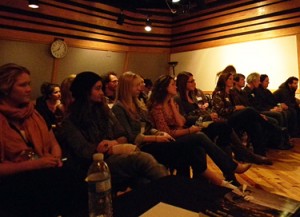 co-writing, the pros and cons of publishing deals, and his lifelong passion for music and songwriting were some major talking points.
co-writing, the pros and cons of publishing deals, and his lifelong passion for music and songwriting were some major talking points.
Some of the perspective he shared that I found most interesting was the sheer number of songs that he writes, stating “I pretty much write at least one song everyday” and that to wind up with five hits songs, he’s probably written 500 songs. He also said that he and his co-writers try to finish a song during each writing appointment, but that he is also interested in experimenting with writing some songs over a longer period of time, noting that “it took Gregg Allman three years to write Melissa”. After his talk concluded he stuck around for a while, giving those who were interested a chance to speak with him one-on-one.
All in all, the event accomplished what we had set out to do. Some of the newest arrivals to Nashville got a chance to reconnect with former classmates that they didn’t even know had moved here, others made new friendships, and many, myself included, got new insights into the ever-changing world of the Nashville music biz’.
I would like to send out a special thanks to the following people for helping make this event a success: Rhett Akins, Karen Bell, Emily Dufresne, Dave Petrelli, Meg O’Brien, NSAI, Berklee, Heston Alley, and Kelly Normand.
Epilogue: I met with Alumni Programs Officer, Emily Dufresne the following afternoon for coffee, and we discussed an idea I had about organizing a monthly “Berklee Alumni Networking Jam”. More info on that will be coming soon!
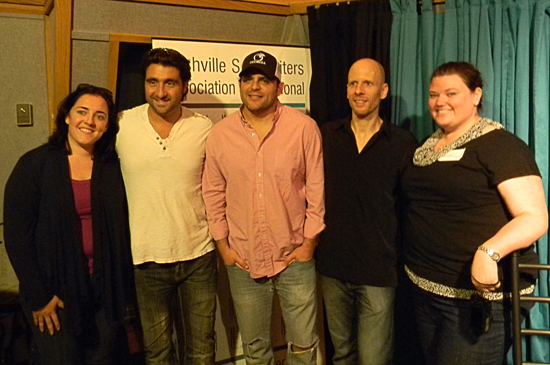 From left to right: Meg O’Brien, Dave Petrelli, Rhett Akins, Eric Normand, Emily Dufresne
From left to right: Meg O’Brien, Dave Petrelli, Rhett Akins, Eric Normand, Emily Dufresne
70 Songs Every Musician Should Know, and Why It’s Important to Know Them
Whether you are a longtime veteran of your local music scene, a recent music school graduate, a hired gun working for a national act, or an aspiring independent artist, you all have something in common – that being a life centered around music. This life of music will lead you into many different performance situations. Like many of my musician friends, I have found myself in a plethora of musical situations over the years; including top 40 bands, rock bands, blues bands, national acts, and start-up original projects, to name a few. I’ve played at festivals, mud bogs, weddings, frat parties, blues jams, jazz jams, open mics, on the Grand Ole Opry, and of course, in nightclubs and bars, the latter being be the arena in which I have probably performed the most.
If there’s one thing I have learned over the years, it’s that you can never have a big enough repertoire. Back in my Berklee days, one of my guitars instructors once told me “You should start building your repertoire of standards. Not only will it help you find your musical voice, it will come in handy down the road”. Twenty-something years and thousands of gigs later, I’ve really come to understand the scope and importance of his words.
Unless you play nothing but your own original music, most live music situations will involve playing a night of cover material, and in my mind, this is a noble cause. The audiences of your typical local bar are usually folks that want to hear some “feel-good music” – familiar, often danceable party tunes that will help them forget about life’s hardships. Before the world had ever heard of “The Beatles”, they were a working cover band, as was Aerosmith, Huey Lewis, and many others.
By the time I entered my nightclub performance years in the late 80s, there was already a few decades of recorded popular music to pick from. Some consider this time period (50s through the 70s) to be the golden era of recorded music. This era gave birth to many songs that are still big crowd-pleasers, those certain tunes that always have a positive impact, no matter what the demographic. While the following decades would add more songs to this pool, it seems that the golden era provides the bulk of what we consider “classic hits” and standards. Over the years, many people have put together lists of the most covered songs, the most popular songs, the greatest hits of all time, etc. In 2004, Rolling Stone Magazine released a list of “500 Greatest Songs of All Time”. Upon scrolling through this list I saw many songs that I had played in different bands and situations over the years.
After cross-referencing that list with the song lists of several modern day cover bands, and comparing that with my own personal experiences, I have come up with a list of what I consider to be songs that every working musician should know. This list is by no means definitive or official; it’s simply my take on the most commonly requested classics, songs that many cover bands have in common, and songs that are often played when guest musicians sit in. Many of these songs are thoroughly worn out and greatly overplayed. Some might argue that many of these tunes have been beaten to death, while others might call this list “Dead Songs That Kill Bands”. Nevertheless, if you are planning on a lifetime of musical performance, knowing these songs, at the absolute least, will come in handy at some point.
| Aint no Sunshine | Bill Withers |
| Ain’t Too Proud to Beg | The Temptations |
| All along the Watchtower | Jimi Hendrix |
| All Right Now | Free |
| Blue Moon Of Kentucky | Patsy Cline |
| Born to Be Wild | Steppenwolf |
| Breakdowm | Tom Petty |
| Brick House | The Commodores |
| Broken Wing | Martina McBride |
| Brown Eyed Girl | Van Morrison |
| Can’t Get Enough | Bad Company |
| Crazy | Patsy Cline |
| Crossroads | Cream |
| Drift Away | Dobi Gray |
| Feelin Allright | Joe Cocker |
| Folsom Prison Blues | Johnny Cash |
| Free Bird | Lynyrd Skynyrd |
| Friends in Low Places | Garth Brooks |
| Georgia | Ray Charles |
| Gimme Three Steps | Lynyrd Skynyrd |
| Good Hearted Woman | Waylon Jennings |
| Hard to Handle | Black Crows |
| He Stopped Loving Her Today | George Jones |
| Hit Me With Your Best Shot | Pat Benatar |
| Honky Tonk Woman | Rolling Stones |
| I Feel Good | James Brown |
| Johnny B Good | Chuck Berry |
| Knock on Wood | Eddie Floyd |
| Knockin on Heavens Door | Bob Dylan |
| Last Chance For Mary Jane | Tom Petty |
| Little Sister | Elvis Presley |
| Long Train Runnin’ | Doobie Brothers |
| Mama Don’t Let Your Babies | Waylon Jennings |
| Margaritaville | Jimmy Buffet |
| Me and Bobby McGee | Janis Joplin |
| Mony Mony | Tommy James & the Shondells |
| Mustang Sally | Wilson Pickett |
| Old Time Rock and Roll | Bob Seger |
| Piece of My Heart | Janis Joplin |
| Pink Houses | John Mellencamp |
| Play That Funky Music | Wild Cherry |
| Pride and Joy | Stevie Ray Vaughn |
| Red House | Jimi Hendrix |
| Redneck Girl | Gretchen Wilson |
| Respect | Aretha Franklin |
| Roadhouse Blues | The Doors |
| Rock ‘n Roll | Led Zeppelin |
| Satisfaction | Rolling Stones |
| Save a Horse Ride a Cowboy | Big and Rich |
| Sittin’ on the Dock of the Bay | Otis Redding |
| Some Kind of Wonderful | Grand Funk Railroad |
| Soulman | Sam and Dave |
| Stand by Your Man | Tammy Wynette |
| Standin On Shaky Ground | Delbert Mcclinton |
| Statesboro Blues | Allman Brothers |
| Stormy Monday | Allman Brothers |
| Summertime | Billy Holiday |
| Superstition | Stevie Wonder |
| Sweet Home Alabama | Lynyrd Skynyrd |
| The Chair | George Strait |
| The Joker | Steve Miller |
| The Thrill Is Gone | BB King |
| Tush | ZZ Top |
| Twist and Shout | The Beatles |
| Walkin’ After Midnight | Patsy Cline |
| What I Like About You | The Romantics |
| Wonderful Tonight | Eric Clapton |
| Workin’ Man Blues | Merle Haggard |
| You Really Got Me | The Kinks |
| You Shook Me All Night Long | ACDC |
Here are a few of what I consider to be the benefits of having a big repertoire of standards:
Requests. If you ever wind up playing some cover gigs, which many musicians do at some point, “standards” will often get requested, and you might find your band “winging” these songs to please audience members. This even happens with national acts.
Sitting in. Having a big repertoire of standards will give you some common ground when sitting in with a band. Back in my New England nightclub days, when friends would sit in with my bands, we would play standards. The same was true when I would sit in with their bands. In Nashville today, sitting in is one of the best ways to build your reputation as a player. Even when superstars sit in, it seems they often choose classic hits or standards over their own material.
Big Tips. If you already play in a cover band, knowing the most popular classics can help you earn some extra tips. I can’t think of how many times someone has said “I’ll give you guys $20 if you play Sweet Home Alabama again.” (Make it an even $50, and it’s a done deal!)
Song Structure. These songs were hits for a reason, and it’s not a coincidence that people still like to hear these songs decades after they were released. Whether it is your desire to be a great performer or a songwriter, internalizing some of these classic hits will teach you song form and structure, and give you perspective about what strikes a chord with the masses.
I would love to hear your thoughts on this list. Are there some songs you feel I missed? Are there songs on here that you think don’t belong? Wherever your musical path might lead, always do your best to smile when playing Mustang Sally, and never accept less than a $20 to play Free Bird!
Playing with Pain: Overcoming and Avoiding Repetitive Motion Injuries
Have you ever experienced hand or arm pain, or pain in your joints when playing a musical instrument? Perhaps you experience this pain while working at a computer or a mixing console? How about weakness or numbness in your hands or fingers? If you have, or do experience any of these symptoms on a regular basis you are not alone, you, like me, are one of many who live with repetitive motion injuries.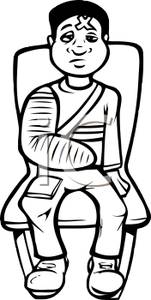
Several years ago, while working on the Toby Keith tour, I was helping the crew load some heavy cases onto a truck. Everything was going fine until one particularly hard-to-maneuver case began to fall off the ramp, with my hand still holding one of the handles. The case didn’t fall completely off the ramp and we were able to pull it back up, but not without my right elbow becoming engulfed in pain. My first thought was that maybe I had sprained something, but I had sprained joints before and they didn’t feel like this. This pain seemed to be centered on my right elbow, and was an intense, burning sensation, like my elbow was on fire. I also felt pain if I squeezed or gripped anything in my right hand. I was instructed by the road manager to get it checked out by a doctor as soon as we returned to Nashville.
At the time of this incident I had already been playing guitar for over 20 years, I had previously worked in construction for several years, and was currently performing a fairly physical job as a guitar tech. All of those years of daily, repetitive hand and arm motions suddenly caught up with me, hurling me full speed into the world of “repetitive motion injuries”. According to the doctors, I had developed tendinitis, and while this incident with the road case may have acted as a trigger, “it had likely been a long time in the making”, they explained. “So how do we heal this?” I asked.
The approach that the doctors chose for me was a regular course of anti-inflammatories, a steroid shot, an arm brace, and the recommendation to “do your best to avoid lifting or gripping anything heavy”, the last piece of advice being somewhat unrealistic for a guitar tech. Although I did follow these recommendations, even adapting some of the physical elements of my job, several weeks later I was still experiencing a lot of pain on a daily basis. It still hurt to grip things with my right hand, and I was beginning to have wrist pain and numbness down my arm. With my situation worsening, the doctors now recommended physical therapy, and this is where I finally began to see some results.
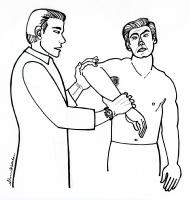 The physical therapist took an entirely different approach. He showed me several hand and arm stretches, which I was instructed to perform daily, he massaged the area of inflammation, and iced it. He showed me how to do the massages myself, and instructed me to do them every morning and night after the stretches, the application of ice always being at the end of the routine. He told me to “listen to my body” and that to perform my regular physical activities as long as they didn’t cause pain. “If an action begins to cause pain, try not to do it.” Making great improvements over the following weeks, I couldn’t understand why the doctors hadn’t recommended any of these approaches. In fact, the doctors did very little to explain the finer points of my affliction, most of what I learned about what causes tendinitis and how to deal with it, I learned from the physical therapist.
The physical therapist took an entirely different approach. He showed me several hand and arm stretches, which I was instructed to perform daily, he massaged the area of inflammation, and iced it. He showed me how to do the massages myself, and instructed me to do them every morning and night after the stretches, the application of ice always being at the end of the routine. He told me to “listen to my body” and that to perform my regular physical activities as long as they didn’t cause pain. “If an action begins to cause pain, try not to do it.” Making great improvements over the following weeks, I couldn’t understand why the doctors hadn’t recommended any of these approaches. In fact, the doctors did very little to explain the finer points of my affliction, most of what I learned about what causes tendinitis and how to deal with it, I learned from the physical therapist.
Over the following months I was able to get an upper hand on my tendinitis, and through regular stretching, didn’t have any more problems for several years. Then I had a setback. One day I was making a homemade pedal board and spent several hours tightly gripping and squeezing a rivet gun. The end result was a resurgence of the pain in my right elbow as intense as that caused by the Toby Keith road case incident. I paid a couple more visits to a physical therapist who was able to help with some soft tissue manipulation, but the biggest thing he did to help me long term was to introduce me to a whole new way of stretching. The following, which I quoted from my book “The Nashville Musicians Survival Guide”, is part of what I learned.
“The muscles in your arms are actually a series of overlapping interconnected muscles, tendons, and ligaments that run from your fingers all the way to your shoulder. It is because of this fact that it is important to also stretch areas of the arm that might not have any pain or problems. Performing stretches that work your wrists, triceps, and shoulders will ultimately help stretch all the muscles and tendons in between.
Stretching an arm with tendinitis is not the same as stretching a healthy arm and requires some caution. Listen to your body. The stretching should cause some sensation but should not be painful. The more you stretch, the more results you will experience. Stretch at regular intervals throughout the day, always making it a point to warm up with some light cardio before your first stretching sequence. (Stretching cold muscles can cause further injury.) If you are gigging, try to stretch before the performance, after the performance, and even in between songs if you have a chance”…
Taken a step further, it only makes sense to stretch and exercise your entire body, as everything is truly connected… the hip bone’s connected to the leg bone, the leg bone’s connected to the…
I was able to eventually get my recent tendinitis flare up under control, but this affliction still haunts me to this day, with a constant effort required to keep it at bay. If I don’t stretch regularly, the pain comes back, and as the body ages it seems like we are more predisposed to injury – gravity is not on our side. That being said, something that has helped me greatly has been an investment in overall physical fitness, health and well-being. I’ve tried a lot of different exercise programs in recent years, my favorite being the “P90X series” of which I have done several rounds. But I must say that yoga seems to be the one exercise that has helped my overall situation the most, it’s absolutely outstanding for overall flexibility.
Eating healthy food doesn’t hurt either. In fact, there are certain foods that increase inflammation, and others that help to decrease inflammation.
Foods that help decrease inflammation:
Foods containing Omega-3 fatty acids like cold water fish, canola oil, and pumpkin seeds; Olive oil, nuts, fruits, vegetables, lean poultry, legumes, tofu, ginger, and some herbal teas
Foods to Avoid
Junk foods, high-fat meats, sugar, and highly processed foods are at the top of this list. Avoid anything that contains high amounts of trans fats and saturated fats like red meat and high-fat processed meats such as bacon and sausage.
For more info on what foods to eat or avoid, follow this link to read the article from which much of this nutritional information was taken, or visit the website, Do It the Hard Way, to learn some nutrition basics and find healthy recipes.
Unfortunately, we live in a society that tends to address problems only as they occur, rather than focusing on prevention. When I think back to all my years of guitar lessons, even my years of music college, no instructor ever told me that repetitive motion injuries exist, let alone how to prevent or deal with them. If you’re a musician and don’t yet have any of these afflictions, it’s obvious that physical fitness and overall health and well-being will reduce your chances of ever having these problems. And if you are “playing with pain”, you’re not alone, there are many of us. But the good news is that most problems are treatable, there are solutions – they just require a little knowledge, a consistent effort, and some self-investment.
“Every human being is the author of his own health or disease.”
— the Buddha
To gain some more perspective on repetitive motion injuries, as well as some of their common misconceptions, follow this link and read “A Cure for Carpal Tunnel Syndrome?” by Jennie Hoeft, as it was reposted on Nashville drummer, Stephen Taylor’s blog.

